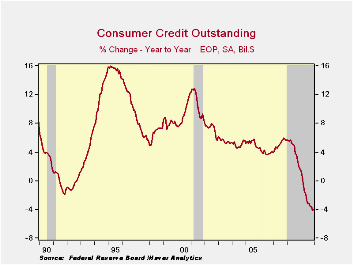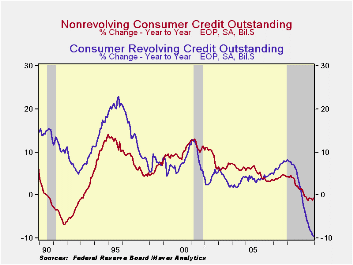 Global| Feb 08 2010
Global| Feb 08 2010U.S. Consumer Credit Becomes Third Rail Of U.S. Economy
by:Tom Moeller
|in:Economy in Brief
Summary
Consumers steered away from credit last year. In fact, they avoided it to a record degree as the outstanding balance fell by $102.3B, or 4.0%, by yearend from 2008. Released late on Friday, the December decline of $1.8B was the [...]
 Consumers
steered away from credit last year. In fact, they avoided it
to a record degree as the outstanding balance fell by $102.3B, or 4.0%,
by yearend from 2008. Released late on Friday, the December decline of
$1.8B was the fifteenth monthly drop since summer 2008 though it was
relatively small. Consumer credit outstanding as a percentage of
disposable income fell to 22.0% from its 2005 high of 24.7%.
Nevertheless, these rates remain up from the low near 16% in
1992.
Consumers
steered away from credit last year. In fact, they avoided it
to a record degree as the outstanding balance fell by $102.3B, or 4.0%,
by yearend from 2008. Released late on Friday, the December decline of
$1.8B was the fifteenth monthly drop since summer 2008 though it was
relatively small. Consumer credit outstanding as a percentage of
disposable income fell to 22.0% from its 2005 high of 24.7%.
Nevertheless, these rates remain up from the low near 16% in
1992.
Revolving credit usage fell $8.5B in December and by a
record 9.5% during the year. That was part of a pullback that began
late in 2008. Finance companies lowered lending by more than one third
y/y, commercial bank lending fell a record 14.1%, pools of securitized
assets fell 2.6% and savings institutions pulled back lending by 6.1%
y/y.  Loans from credit unions offset some of these declines with a 6.3%
increase.
Loans from credit unions offset some of these declines with a 6.3%
increase.
Usage of non-revolving credit (autos & other consumer durables), which accounts for nearly two-thirds of the total, rose $6.8B for December and recouped most of the November decline. Nevertheless, the 0.7% y/y decline was the first since 1992. It reflected a 13.8% shortfall in pools of securitized assets, an 11.7% decline in finance company lending and a 7.2% drop in nonfinancial business credit extensions. These declines were mostly offset by the federal government & Sallie Mae which expanded lending by more than two-thirds y/y.
These figures are the major input to the Fed's quarterly Flow of Funds accounts for the household sector.
Credit data are available in Haver's USECON database. The Flow of Funds data are in Haver's FFUNDS database.
Measuring the equilibrium real interest rate from the Federal Reserve Bank of Chicago is available here.
| Consumer Credit Outstanding (m/m Chg, SAAR) | December | November | October | Y/Y | 2009 | 2008 | 2007 |
|---|---|---|---|---|---|---|---|
| Total | $-1.8 | $-21.8B | $-5.7B | -4.0% | -4.0% | 1.6% | 5.6% |
| Revolving | $-8.5 | $-13.8B | $-6.7B | -9.5% | -9.5 | 1.9% | 7.8% |
| Non-revolving | $6.8 | $-8.0B | $1.1B | -0.7% | -0.7% | 1.4% | 4.4% |
Tom Moeller
AuthorMore in Author Profile »Prior to joining Haver Analytics in 2000, Mr. Moeller worked as the Economist at Chancellor Capital Management from 1985 to 1999. There, he developed comprehensive economic forecasts and interpreted economic data for equity and fixed income portfolio managers. Also at Chancellor, Mr. Moeller worked as an equity analyst and was responsible for researching and rating companies in the economically sensitive automobile and housing industries for investment in Chancellor’s equity portfolio. Prior to joining Chancellor, Mr. Moeller was an Economist at Citibank from 1979 to 1984. He also analyzed pricing behavior in the metals industry for the Council on Wage and Price Stability in Washington, D.C. In 1999, Mr. Moeller received the award for most accurate forecast from the Forecasters' Club of New York. From 1990 to 1992 he was President of the New York Association for Business Economists. Mr. Moeller earned an M.B.A. in Finance from Fordham University, where he graduated in 1987. He holds a Bachelor of Arts in Economics from George Washington University.






